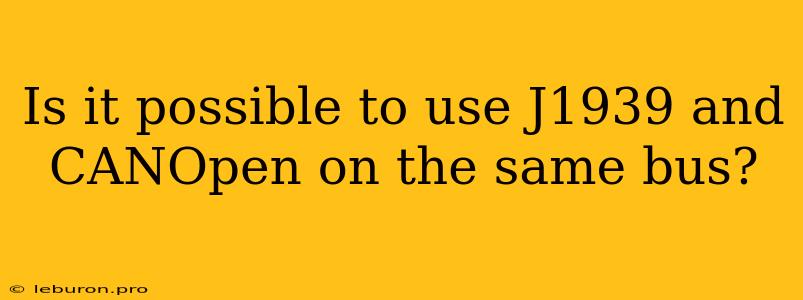Can J1939 and CANopen Coexist on the Same Bus?
The question of whether J1939 and CANopen can coexist on the same bus is a common one in the realm of industrial automation and vehicle communication. Both protocols utilize the Controller Area Network (CAN) bus, a robust and widely used communication standard. However, they differ in their intended applications, message structure, and addressing schemes, raising concerns about potential conflicts and compatibility issues.
While the physical layer of both protocols is identical, using the same CAN bus, the differences in their application layers make it challenging to implement both simultaneously without careful consideration.
Understanding J1939 and CANopen
J1939
J1939 is primarily used in heavy-duty vehicles, including trucks, buses, and agricultural equipment. It's designed for transmitting data related to engine parameters, transmission control, vehicle diagnostics, and other critical functions. Key features of J1939 include:
- Physical addressing: Uses a 29-bit identifier system, allowing for a large number of nodes on the bus.
- Message structure: Utilizes extended frames (11-bit identifiers) and defines specific data types and formats for various vehicle functions.
- Error handling: Implements robust error detection and correction mechanisms to ensure reliable communication.
CANopen
CANopen is a widely adopted application layer protocol for industrial automation. It provides a standardized communication framework for various devices and systems, including sensors, actuators, controllers, and human-machine interfaces (HMIs). Key features of CANopen include:
- Logical addressing: Uses object dictionary (OD) concept, where each device has a unique address and data is accessed through specific object IDs.
- Data types and formats: Defines specific data types and formats for various industrial applications, such as control signals, process data, and diagnostic information.
- Service-oriented communication: Uses a service-oriented architecture for communication, allowing for a flexible and scalable approach.
Challenges and Solutions for Coexistence
The primary challenge of combining J1939 and CANopen on the same bus lies in potential collisions and interference due to the different message formats and addressing schemes. To overcome these challenges, several approaches can be implemented:
1. Time-division multiplexing (TDM)
This technique involves dividing the CAN bus time into slots, allocating specific slots for J1939 messages and others for CANopen messages. This ensures that messages from each protocol don't interfere with each other, allowing them to coexist on the same bus.
2. Separate physical buses
For applications requiring high bandwidth or critical data transfer, it might be more practical to use separate physical buses for J1939 and CANopen. This approach eliminates any potential for interference and provides dedicated communication channels for each protocol.
3. Protocol gateways
A protocol gateway acts as a translator between J1939 and CANopen. It receives messages from one protocol, converts them into the format of the other, and sends them across the bus. This solution allows devices using different protocols to communicate seamlessly without needing to directly interact with each other.
4. Protocol stacks
Advanced microcontrollers or embedded systems can support both J1939 and CANopen protocol stacks. This allows a single device to handle messages from both protocols simultaneously. However, careful implementation and testing are crucial to ensure reliable operation and avoid conflicts.
Considerations for Implementation
When considering using J1939 and CANopen on the same bus, several factors should be taken into account:
- Traffic load: Estimate the amount of traffic generated by both protocols to ensure that the bus bandwidth is sufficient to handle all messages without delays or collisions.
- Priority levels: Assign priorities to messages from each protocol based on their criticality. For example, safety-critical J1939 messages might have higher priority than non-critical CANopen messages.
- Synchronization: Ensure that the message timings for both protocols are properly synchronized to avoid conflicts and data loss.
- Testing: Conduct thorough testing to verify that the communication system operates correctly and handles potential conflicts effectively.
Conclusion
Using J1939 and CANopen on the same bus is possible, but it requires careful planning and implementation to avoid conflicts and ensure reliable communication. Choosing the appropriate solution, whether TDM, separate buses, protocol gateways, or protocol stacks, depends on the specific application requirements and traffic load. It's also essential to conduct thorough testing and address potential issues to ensure the system's robustness and reliability. As technology evolves, we can expect further advancements in protocol integration and compatibility, enabling more efficient and seamless communication between devices utilizing different standards on the same bus.
